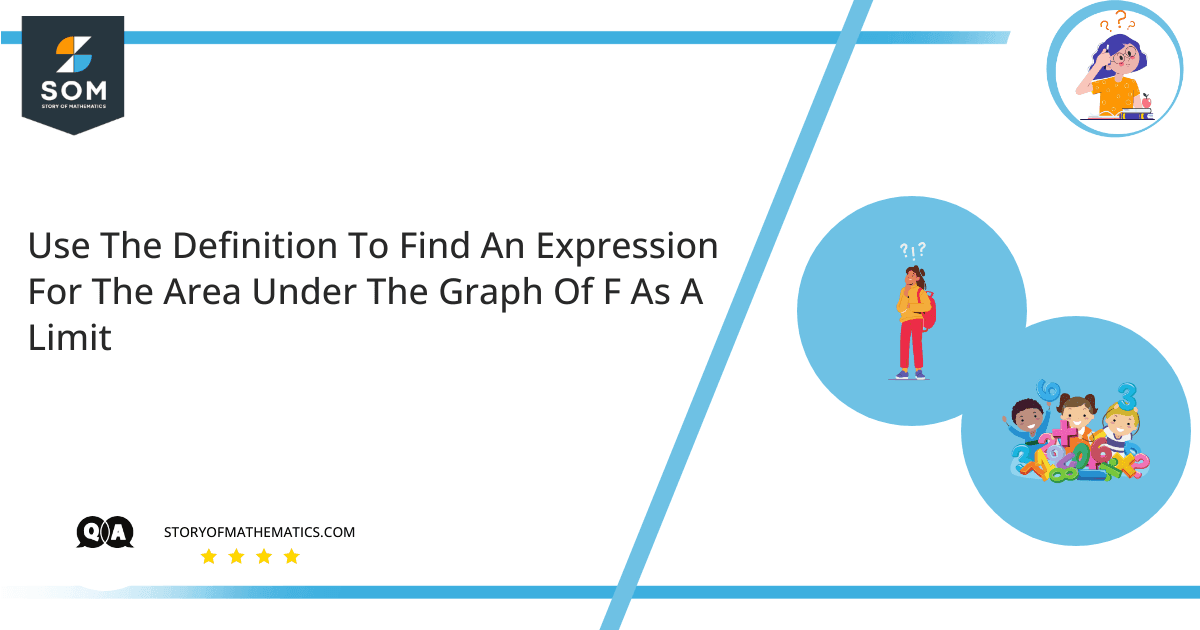
$ f ( x ) = \dfrac { 2 x } { x ^ { 2 } + 1 } , 1 \leq x \leq 3 $
This article aims to write the expression for the area under the graph. The article uses the concept of definition $ 2 $ to find the expression for the area under the graph. The definition $ 2 $ states that:
\[ Area =\lim_{ n \to \infty } \Delta x \sum_{ i = 1 } ^ { n } f( x _ { i } )\]
Where:
\[ \Delta = \dfrac { b – a } { n } \]
Expert Answer
The definition $ 2 $ states that:
\[ Area =\lim_{ n \to \infty } \Delta x \sum_{i=1}^{n} f(x_{i})\]
Where:
\[\Delta = \dfrac { b – a } { n } \]
If we choose $ x_{i} $ as the right endpoint of each interval, then:
\[ Area =\lim_{ b \to \infty } \Delta x \sum_{ i = 1 } ^ { n } f( a + i \Delta x )\]
In this article:
\[ f ( x ) = \dfrac { 2 x } { x ^ { 2 } + 1 } \]
\[a = 1, b = 3\]
Hence,
\[ \Delta x = \dfrac { b – a } { n } = \dfrac { 3 – 1 } { n } = \dfrac { 2 } { n } \]
\[ Area =\lim_{ b \to \infty } \Delta x \sum_{ i = 1 } ^ { n } f ( a + i \Delta x ) = \lim_{ n \to \infty } \dfrac { 2 } { n } \sum_{ i = 1 } ^ { n } f ( 1 + i . \dfrac { 2 } { n } ) \]
\[= \lim_{n \to \infty} \dfrac{2}{n} \sum_{i=1}^{n} \dfrac{ 2[1 + \dfrac { 2i } { n } ] }{[1 + \dfrac { 2 i } { n }] ^ { 2 } + 1 } \]
The expression for the area under the curve is $\lim_{n \to \infty} \dfrac{2}{n} \sum_{i=1}^{n} \dfrac{2[1+\dfrac{2i}{n}]}{[1+\dfrac{2i}{n}]^{2}+1} $.
Numerical Results
The expression for the area under the curve is $\lim_{n \to \infty} \dfrac{2}{n} \sum_{i=1}^{n} \dfrac{2[1+\dfrac{2i}{n}]}{[1+\dfrac{2i}{n}]^{2}+1} $.
Example
Use definition $2$ to find an expression for area under the graph and with the limit. Do not evaluate the limit.
$ f ( x ) = \dfrac { 4 x } { x ^ { 2 } – 1 } , 1 \leq x \leq 4 $
Solution
The definition $ 2 $ states that:
\[ Area =\lim_{ n \to \infty } \Delta x \sum_{i=1}^{n} f(x_{i})\]
Where:
\[\Delta = \dfrac{b-a}{n}\]
If we choose $ x_{i} $ as the right endpoint of each interval, then:
\[ Area =\lim_{ b \to \infty } \Delta x \sum_{i=1}^{n} f(a+i\Delta x )\]
In this article:
\[f(x) = \dfrac{4x}{x^{2}-1}\]
\[a = 1, b = 4\]
Hence,
\[\Delta x = \dfrac{b-a}{n} = \dfrac{4-1}{n} = \dfrac{3}{n} \]
\[ Area =\lim_{ b \to \infty } \Delta x \sum_{i=1}^{n} f(a+i\Delta x ) = \lim_{n \to \infty} \dfrac{3}{n} \sum_{i=1}^{n} f(1+i.\dfrac{3}{n}) \]
\[= \lim_{n \to \infty} \dfrac{3}{n} \sum_{i=1}^{n} \dfrac{4[1+\dfrac{3i}{n}]}{[1+\dfrac{3i}{n}]^{2}-1} \]
The expression for the area under curve is $\lim_{n \to \infty} \dfrac{3}{n} \sum_{i=1}^{n} \dfrac{4[1+\dfrac{3i}{n}]}{[1+\dfrac{3i}{n}]^{2}-1} $.
